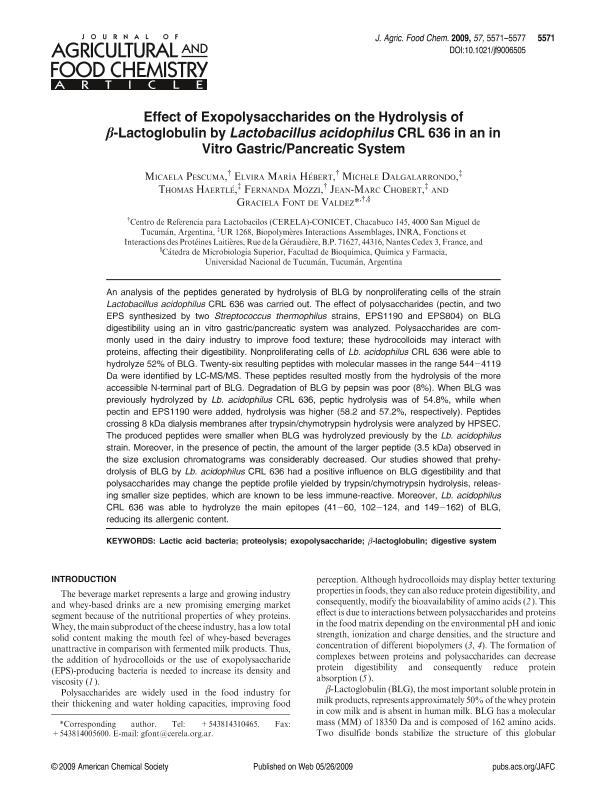Mostrar el registro sencillo del ítem
dc.contributor.author
Pescuma, Micaela

dc.contributor.author
Hebert, Elvira Maria

dc.contributor.author
Dalgalarrondo, Michèle
dc.contributor.author
Haertlé, Thomas
dc.contributor.author
Mozzi, Fernanda Beatriz

dc.contributor.author
Chobert, Jean Marc
dc.contributor.author
Font, Graciela Maria

dc.date.available
2018-08-07T17:44:58Z
dc.date.issued
2009-06-24
dc.identifier.citation
Pescuma, Micaela; Hebert, Elvira Maria; Dalgalarrondo, Michèle; Haertlé, Thomas; Mozzi, Fernanda Beatriz; et al.; Effect of exopolysaccharides on the hydrolysis of ß-lactoglobulin by lactobacillus acidophilus CRL 636 in an in vitro gastric/pancreatic system; American Chemical Society; Journal of Agricultural and Food Chemistry; 57; 12; 24-6-2009; 5571-5577
dc.identifier.issn
0021-8561
dc.identifier.uri
http://hdl.handle.net/11336/54448
dc.description.abstract
An analysis of the peptides generated by hydrolysis of BLG by nonproliferating cells of the strain Lactobacillus acidophilus CRL 636 was carried out. The effect of polysaccharides (pectin, and two EPS synthesized by two Streptococcus thermophilus strains, EPS1190 and EPS804) on BLG digestibility using an in vitro gastric/pancreatic system was analyzed. Polysaccharides are commonly used in the dairy industry to improve food texture; these hydrocolloids may interact with proteins, affecting their digestibility. Nonproliferating cells of Lb. acidophilus CRL 636 were able to hydrolyze 52% of BLG. Twenty-six resulting peptides with molecular masses in the range 544-4119 Da were identified by LC-MS/MS. These peptides resulted mostly from the hydrolysis of the more accessible N-terminal part of BLG. Degradation of BLG by pepsin was poor (8%). When BLG was previously hydrolyzed by Lb. acidophilus CRL 636, peptic hydrolysis was of 54.8%, while when pectin and EPS1190 were added, hydrolysis was higher (58.2 and 57.2%, respectively). Peptides crossing 8 kDa dialysis membranes after trypsin/chymotrypsin hydrolysis were analyzed by HPSEC. The produced peptides were smaller when BLG was hydrolyzed previously by the Lb. acidophilus strain. Moreover, in the presence of pectin, the amount of the larger peptide (3.5 kDa) observed in the size exclusion chromatograms was considerably decreased. Our studies showed that prehydrolysis of BLG by Lb. acidophilus CRL 636 had a positive influence on BLG digestibility and that polysaccharides may change the peptide profile yielded by trypsin/chymotrypsin hydrolysis, releasing smaller size peptides, which are known to be less immune-reactive. Moreover, Lb. acidophilus CRL 636 was able to hydrolyze the main epitopes (41-60, 102-124, and 149-162) of BLG, reducing its allergenic content.
dc.format
application/pdf
dc.language.iso
eng
dc.publisher
American Chemical Society

dc.rights
info:eu-repo/semantics/openAccess
dc.rights.uri
https://creativecommons.org/licenses/by-nc-sa/2.5/ar/
dc.subject
Ss-Lactoglobulin
dc.subject
Digestive System
dc.subject
Exopolysaccharide
dc.subject
Lactic Acid Bacteria
dc.subject
Proteolysis
dc.subject.classification
Otras Ciencias Químicas

dc.subject.classification
Ciencias Químicas

dc.subject.classification
CIENCIAS NATURALES Y EXACTAS

dc.subject.classification
Física Atómica, Molecular y Química

dc.subject.classification
Ciencias Físicas

dc.subject.classification
CIENCIAS NATURALES Y EXACTAS

dc.title
Effect of exopolysaccharides on the hydrolysis of ß-lactoglobulin by lactobacillus acidophilus CRL 636 in an in vitro gastric/pancreatic system
dc.type
info:eu-repo/semantics/article
dc.type
info:ar-repo/semantics/artículo
dc.type
info:eu-repo/semantics/publishedVersion
dc.date.updated
2018-04-16T14:28:36Z
dc.identifier.eissn
1520-5118
dc.journal.volume
57
dc.journal.number
12
dc.journal.pagination
5571-5577
dc.journal.pais
Estados Unidos

dc.journal.ciudad
Washington DC
dc.description.fil
Fil: Pescuma, Micaela. Consejo Nacional de Investigaciones Científicas y Técnicas. Centro Científico Tecnológico Conicet - Tucumán. Centro de Referencia para Lactobacilos; Argentina
dc.description.fil
Fil: Hebert, Elvira Maria. Consejo Nacional de Investigaciones Científicas y Técnicas. Centro Científico Tecnológico Conicet - Tucumán. Centro de Referencia para Lactobacilos; Argentina
dc.description.fil
Fil: Dalgalarrondo, Michèle. Institut National de la Recherche Agronomique; Francia
dc.description.fil
Fil: Haertlé, Thomas. Institut National de la Recherche Agronomique; Francia
dc.description.fil
Fil: Mozzi, Fernanda Beatriz. Consejo Nacional de Investigaciones Científicas y Técnicas. Centro Científico Tecnológico Conicet - Tucumán. Centro de Referencia para Lactobacilos; Argentina
dc.description.fil
Fil: Chobert, Jean Marc. Institut National de la Recherche Agronomique; Francia
dc.description.fil
Fil: Font, Graciela Maria. Consejo Nacional de Investigaciones Científicas y Técnicas. Centro Científico Tecnológico Conicet - Tucumán. Centro de Referencia para Lactobacilos; Argentina. Universidad Nacional de Tucumán. Facultad de Bioquímica, Química y Farmacia; Argentina
dc.journal.title
Journal of Agricultural and Food Chemistry

dc.relation.alternativeid
info:eu-repo/semantics/altIdentifier/doi/http://dx.doi.org/10.1021/jf9006505
dc.relation.alternativeid
info:eu-repo/semantics/altIdentifier/url/https://pubs.acs.org/doi/abs/10.1021/jf9006505
Archivos asociados
